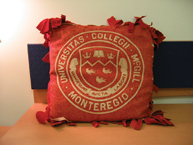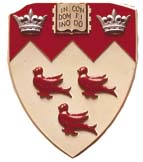Flight through history
A look at the Martlet, McGill's beloved icon
Three cheery red birds called Martlets are one of McGill's most recognizable symbols, and part of the coat of arms.
The mythical birds cannot land because they have no feet — tufts of feathers appear in the place of legs. They tend to be depicted in groups, too. Ever in flight and sociable: Seems like a pretty apt representation of university life.
The three Martlets have appeared in coats of arms since the mid 1800s — first on diplomas in 1850, then on the annual calendar in 1861. Officially described as "argent [silver] three martlets jules [red]," the crimson birds on a white background are taken from James McGill's crest, but with the colours reversed. (Strictly speaking, a "coat of arms" is used by an institution, while a "crest" is granted for personal use only.)
In 1922, Principal Sir Arthur Currie asked architecture professor Percy Nobbs to design a coat of arms, the patent for which was granted that year by the Garter-King-at-Arms in London, England. Different versions of the coat-of-arms were in use until 1975, when McGill's Board of Governors settled upon the one we see today. This was registered with the Chief Herald of Canada in 1992.

Detail of 1967 invitation from then-Principal Rocke Robertson

1948 program cover for annual student talent show
The Martlet has been used at McGill in a variety of ways, including a "piggy bank" for a fundraising campaign (Director and University Archivist Johanne Pelletier keeps a Martlet bank, fondly dubbed Alma, on her desk). In 1976, the name Martlets was adopted by McGill women's varsity teams. And as you can see below, they've appeared on posters and playbills.
It looks like Martlets will finally rest on land for their latest likeness. McGill's green thumbs are installing a floral coat of arms in front of James McGill's grave, just in time for convocation.
Images courtesy of McGill Archives. Many thanks to crack archivist and records analyst Aaron Spreng.

Cover of Open House program

Pillow donated to Archives from the Students' Society of McGill University
 Football program from 1961 |
 Description of the coat of arms |
 The 1922 patent for the pageant of arms |





